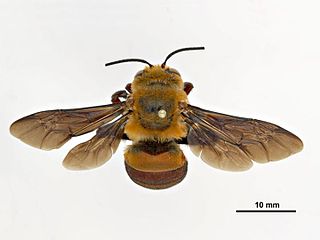
Buzz pollination or sonication is a technique used by some bees, such as solitary bees, to release pollen which is more or less firmly held by the anthers. The anthers of buzz-pollinated plant species are typically tubular, with an opening at only one end, and the pollen inside is smooth-grained and firmly attached. With self-fertile plants such as tomatoes, wind may be sufficient to shake loose the pollen through pores in the anther and accomplish pollination. Visits by bees may also shake loose some pollen, but more efficient pollination of those plants is accomplished by a few insect species who specialize in sonication or buzz pollination.

The term cuckoo bee is used for a variety of different bee lineages which have evolved the kleptoparasitic behaviour of laying their eggs in the nests of other bees, reminiscent of the behavior of cuckoo birds. The name is perhaps best applied to the apid subfamily Nomadinae, but is commonly used in Europe to mean bumblebees Bombus subgenus Psithyrus. Females of cuckoo bees are easy to recognize in almost all cases, as they lack pollen-collecting structures and do not construct their own nests. They often have reduced body hair, abnormally thick and/or heavily sculptured exoskeleton, and saber-like mandibles, although this is not universally true; other less visible changes are also common.

Australian native bees are a group of bees that play a crucial role in the pollination of native plants. There are over 1,700 species of native bees in Australia, ranging from small solitary bees to the social stingless bees. Native bees are important for native ecosystems, providing pollination services to native plants, and hold value for Australian agriculture.

Corda is a settlement in the island of Santo Antão, Cape Verde. It is part of the municipality Ribeira Grande. It is situated in the mountainous interior of the island at about 1,000 meters elevation, 13 km north of the island capital Porto Novo. Corda consists of several villages, including Chã de Corda and Esponjeiro. The national road from Porto Novo to Ribeira Grande (EN1-SA01) passes through Corda. The crater of Cova lies 4 km to the southeast. Corda lies in the Cova-Paul-Ribeira da Torre Natural Park.

Amegilla is a large genus of bees in the tribe Anthophorini.

Amegilla cingulata is a species of blue-banded bee native to Australia. Currently, several scientific organizations are conducting research on how A. cingulata benefits agriculture through its distinctive "buzz pollination".

Phalaenopsis pulcherrima is a species of orchid found from Hainan Island to western Malesia.

Thyreus is an Old World genus of bees, one of many that are commonly known as cuckoo bees, or cloak-and-dagger bees, and are kleptoparasites of other species of bees, mostly in the genus Amegilla. They all have strongly contrasting patterns of coloration – three species from the Sydney region, Thyreus nitidulus, T. lugubris, and T. caeruleopunctatus are bright blue and black.

Thyreus nitidulus, commonly known as the neon cuckoo bee, is a parasitic bee of the genus Thyreus, called cuckoo bees. It is a stocky bee, notable for its brilliant metallic blue- and black-banded colors.

Amegilla bombiformis, commonly known as the teddy bear bee or golden haired mortar bee, is an Australian native bee in the family Apidae.

Amegilla dawsoni, sometimes called the Dawson's burrowing bee, is a species of bee that nests by the thousands in arid claypans in Western Australia. It is a long tongued bee, of the tribe Anthophorini and genus Amegilla, the second largest genus in Anthophorini.

Thyreus lugubris, common name the domino cuckoo bee, is a species of Australian native bee belonging to the family Apidae, subfamily Apinae.

Amegilla asserta is a species of bee endemic to Australia, belonging to the family Apidae subfamily Apinae. Females forage by performing buzz pollination.
Thyreus ramosellus, is a species of bee belonging to the family Apidae subfamily Apinae.
Josephine Christina Cardale worked as an entomologist for CSIRO from 1967 to 2001. She was a collection manager of Hymenoptera at the Australian National Insect Collection.
Thyreus abdominalis is a species of bee belonging to the genus Thyreus, the members of which are often referred to as cuckoo bees. Like all bees in this genus, it is kleptoparasitic. It is found throughout southern and eastern Asia.

Thyreus denolli is an African species of kleptoparisitic bee. It belongs to the tribe Melectini and to the genus Thyreus, the members of which are often referred to as 'Cuckoo bees', due to their parasitic behaviour. It is one of the most distinctive Thyreus bees in Cape Verde.

Kit Prendergast, nicknamed "The Bee Babette", is a wild bee ecologist from Perth, Western Australia.

Amegilla albiceps is a species of bee native to Australia. It has a southern temperate distribution, with records from South Australia and Victoria. A member of the genus Amegilla, it was described in 1951 by Tarlton Rayment. Adults have been found from October to April, and they have been observed visiting flowers of the mistletoe genus Amyema.
















